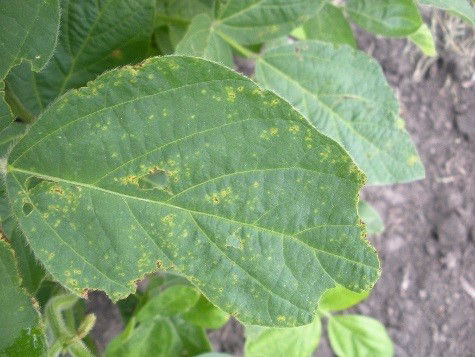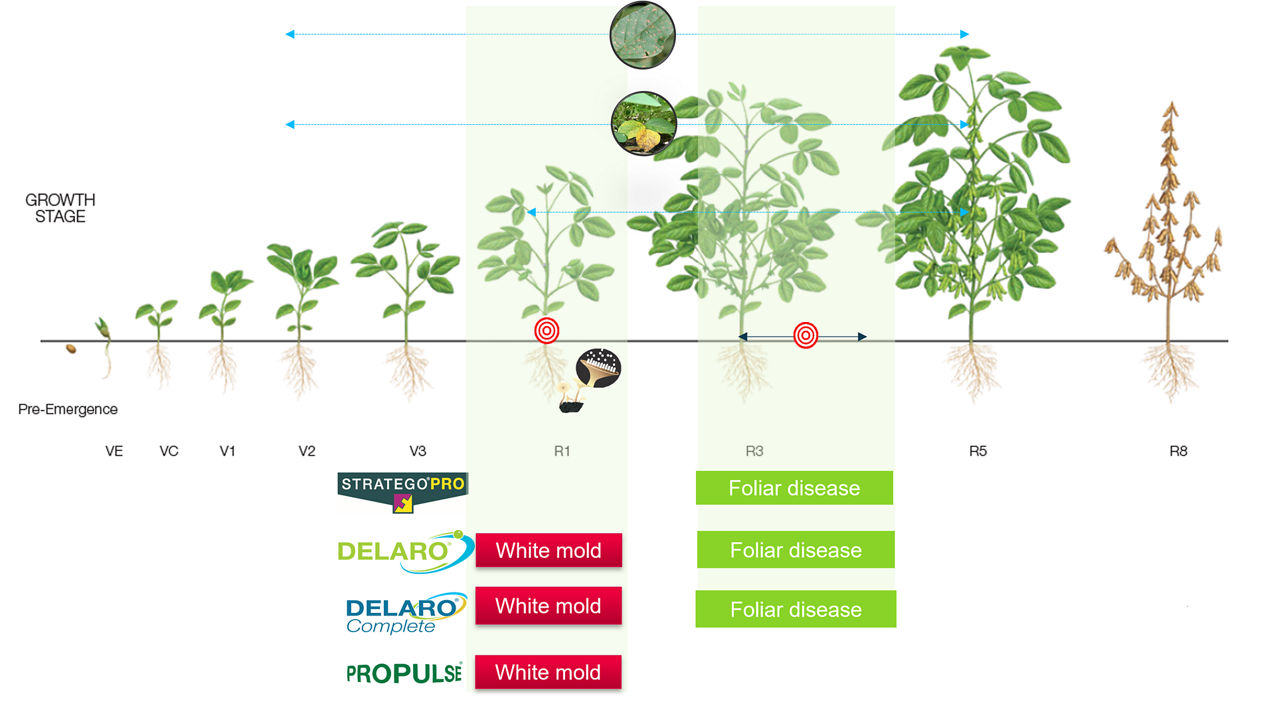20 MIN READ
ID of Late-season Soybean Diseases
August 31, 2023
During the growing season, soybean may develop bacterial, fungal, and viral diseases, or the plants may be damaged by nematode infestations. The development of these diseases depends on several factors and the interactions between those factors, including the environmental and agronomic conditions. Disease development is greatly influenced by the amount of rainfall (or lack thereof), seasonal temperatures, and timing of infection. Soybean products’ genetic tolerance, or susceptibility, can also influence the development of diseases. Knowing the tolerance levels of soybean products can help determine if a disease could become economically damaging. Finally, for some diseases, while infection may occur early in the growing season the identifiable effects will not appear until just prior to or during the reproductive growth stages.
Development of a bacterial disease generally depends on plant injury from hail, wind, insects, or mechanical injuries, and by movement through the crop by animals, equipment, or humans when the plants are wet. The disease-causing bacteria can enter the plant through the wounds or natural leaf openings (stomates) in the plant, and then overwinter on residue and within seeds.
Development of a fungal disease depends on the presence of fungal spores, which can come from infected residue from a previous crop, infected seed, or from spore-carrying winds. With the right temperature and sufficient moisture, spores can be produced on residue and be transmitted to the growing crop through splashing rain or wind. However, some fungal diseases are unable to overwinter on previous residue in the local climatic conditions. For these diseases, the infecting spores will need to be carried by wind from areas where the disease can overwinter. Foliar fungicides may help protect yield potential against certain fungal diseases, depending on the fungal disease and application timing.
Viral diseases are generally vectored by insects such as aphids or bean leaf beetles, but they can also be seedborne. If the insect vectors are present, their associated viral diseases may be present as well. Scouting for insects that have the potential to vector viral diseases and applying a timely insecticide may help protect plants from becoming infected, but many viral diseases cannot be adequately managed by insecticides.
The potential for microscopic nematodes to infest fields depends on geography, soil type, previous crop, tillage, wildlife and livestock movement, and other factors. Soil and plant sampling can help identify the species and level of infestation.
Click on a disease to learn more

Identification, Characteristics, and Diagnosis:
- Caused by the bacterium Pseudomonas syringae pv. glycinea.
- More prevalent during the early part of the growing season but can appear late.
- Late-season symptoms include the development of angular lesions that form from small, yellow to brown leaf spots (Figure 1).
- Spots appear first in the mid to upper canopy.
- Spot centers turn dark reddish-brown to black and dry out.
- Tissue around the spots appears water soaked and develops a yellowish-green halo.
- Dried out lesions can drop from the leaf, giving the leaf a shot-holed appearance.
- Plant seeds may be shriveled and discolored.
- The bacterium overwinters in crop residue and seed.
- Spread by wind-driven rain or splashing water, cultivation when foliage is wet, and moving wildlife.
- Bacterium enters the plant through natural openings and wounds when leaf surfaces are wet.
- Favored by temperatures in the range of 70 to 80°F.
Management:
- Consider planting soybean products with higher tolerance ratings.
- Rotate to non-susceptible crops such as corn or small grains.
- Incorporate residue.
- Avoid cultivation when foliage is wet.
- Fungicides containing copper may provide control if applied early in the disease cycle.

Identification, Characteristics, and Diagnosis:
- Caused by the bacterium Xanthomonas axonopdis (syn. Campestris) pv. glycines.
- Causes premature defoliation, reduced seed size, and reduced seed set.
- Initial symptoms include tiny, pale-green leaf spots with raised centers. Spots can be on either side of the leaf but primarily occur on the lower surface and are near the main leaf veins (Figure 2).
- Later symptoms include the development of light-colored pustules in the center of the spots.
- Pustules may have linear cracks across the top, distinct from the round openings that appear in soybean rust pustules. Additionally, bacterial pustules do not produce spores.
- In contrast to bacterial blight (Pseudomonas syringae pv. glycinea), water soaking is not present with bacterial pustule.
- Overwinters in crop residue and in seeds.
- Spread by wind-driven rain or splashing water, cultivation when foliage is wet, and moving wildlife.
- Bacterium enters the plant through natural openings and wounds.
- Favored by temperatures in the range of 86 to 92°F.
Management:
- Consider planting soybean products with higher tolerance ratings.
- Rotate to non-susceptible crops such as corn or small grains.
- Incorporate residue.
- Avoid cultivation when foliage is wet.

Sources:
Byamukama, E. 2022 Late-season soybean diseases: Know what’s killing your soybeans. South Dakota State University Extension. https://extension.sdstate.edu/late-season-soybean-diseases-know-whats-killing-your-soybeans
Dorrance, A. 2020 How to identify late season soybean diseases in 2020. C.O.R.N. Newsletter. 2020-27. Agronomic Crops Network. Ohio State University Extension. https://agcrops.osu.edu/newsletter/corn-newsletter/2020-27/how-identify-late-season-soybean-diseases-2020
Jackson-Ziems, T. and Broderick, K. 2019. Late season soybean diseases widespread in areas of Nebraska. CROPWATCHJ. University of Nebraska-Lincoln. Institute of Agriculture and Natural Resources. https://cropwatch.unl.edu/2019/late-season-soybean-diseases-widespread-areas-nebraska
Sweets, L. 2013. Late season soybean diseases. Integrated Pest Management. University of Missouri. https://ipm.missouri.edu/cropPest/2013/8/Late-Season-Soybean-Diseases/.
Markell, S. and Malvick, D. 2021. Soybean disease diagnostic series. PP1867. North Dakota State University. https://www.ndsu.edu/agriculture/ag-hub/publications/soybean-disease-diagnostic-series.
Kirkpatrick, T. and Faske, T. Soybean pest management. Soybean Nematodes. University of Arkansas. Division of Agriculture Research & Extension. Cooperative Extension Service. https://www.uaex.uada.edu/farm-ranch/pest-management/plant-disease/field-crop-diseases/soybeans/nematodes.aspx.
1311_143127